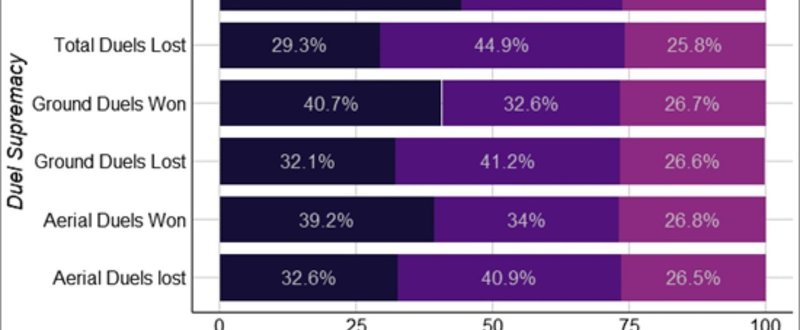
フットボール統計学 デュエルを評価するための新指標(前編)
The Liverpool defender and legendary hard man Tommy Smith is supposed to have said: "The ball may pass, the man may pass but never the two together." Football has become less bloodthirsty since Smith last played for Liverpool in 1978, but performance in 1v1 contests remains a key element of the game.
リバプールのDFで伝説的な激しい守備で知られるトミー・スミスは、「ボールは通過するかもしれない。相手が通過するかもしれない。しかし2つ両方とも通過することは決してない」フットボールは彼がリヴァプールでプレーしていた1978年までよりも殺伐とはしていないが、1対1でのパフォーマンスは試合の重要な要素であり続けている。
Opta recognizes several types of 1v1 event, collectively known as duels. Aerial duels occur when two players contest a ball in the air; this is a symmetrical event because neither player starts with possession. Ground duels are asymmetrical events, because one player has possession and the other is trying to regain it. Frequently it is the attacker that has possession, rather than the defender; however, in this article I want to rank attackers and defenders on the same scale, so I will not distinguish between the two sides of the duel, the only variable of interest is who wins it. Opta also includes fouls within the duel category, and accordingly I include them as well.
Optaは、いくつかの種類の1対1イベントを認識し、これらはまとめて「デュエル」と呼ばれる。空中戦は、2人の選手が空中でボールに争うときに発生する。どちらの選手もポゼッションを始めないため、これは対称的なイベントである。地上のデュエルは非対称的な出来事であり、なぜなら1人の選手がポゼッションを持ち、もう1人がボールを回復しようとしているからである。しばしば守備側ではなく、ポゼッションしているのは攻撃側であることが多い。しかし、この記事では、同じスケールで攻撃者と守備側をランク付けしたいので、私(Garry Gelade氏)はデュエルの両面を区別しない。興味のある変数は勝者のみである。Optaには、デュエル部門内のファウルも含まれているので、同様にそれらも含める。
In this post I discuss the evaluation of player 1v1 abilities within this framework. I will keep ground and aerial duels separate; these are statistically two different kinds of skill, and a player who ranks highly on does not necessarily rank highly on the other.
この記事では、このフレームワーク内での選手の1対1の能力の評価について議論する。地上戦と空中戦を別々に保つ。これらは統計的に2つの異なる種類のスキルであり、片方で上位にランクインしている選手が、必ずしも他方で高いランクを付けているとは限らない。
1v1 abilities are traditionally assessed on a simple percentage basis; a player’s duel success rate is:
Duel success rate = Number of duels won / total number of duels
1対1の能力は伝統的に単純なパーセンテージベースで評価される。選手のデュエル成功率は次のとおりである。
デュエル成功率=デュエル勝利数/デュエル総数
This is reasonable, but it does not take opponents’ abilities into account. For large numbers of encounters between randomly selected opponents, opponent ability averages out. But we cannot assume that players are randomly paired in practice. For one thing, managers often assign their best defenders to mark the most dangerous attackers, so that dangerous attackers face stronger opposition than their less dangerous counterparts. Percentage success rates will therefore underestimate the ability of the dangerous attackers and overestimate the ability of the less dangerous ones. The same thing applies to defenders.
これは合理的であるが、対戦相手の能力を考慮に入れていない。ランダムに選択された対戦相手の間の多数のマッチアップに対して、対戦相手の能力は平均化される。しかし、実際に選手がランダムにペアになっているとは想定できない。1つは、指揮官は最も危険なアタッカーをマークするために最善のディフェンダーを割り当てることが多いため、危険なアタッカーは危険性の低い攻撃陣より強い相手に直面することがある。従って成功率のパーセンテージは、危険なアタッカーの能力を過小評価し、危険性の低いアタッカーの能力を過大評価する。ディフェンダーにも同じことが当てはまる。
Here I use the ’Bradley-Terry‘ model to explicitly model opponent ability. A key question is how the Bradley-Terry ratings compare with the duel success rate, and we shall see there are some surprising differences in how certain players are evaluated.
ここでは、明示的に相手の能力をモデル化するために'Bradley-Terry'モデルを使用する。重要な問題は、どのようにBradley-Terryの評価がデュエル成功率を比較するのかであり、特定の選手の評価方法には驚くべき違いがあることがわかる。
But first, let’s look at some general features of duels and how they fit into the wider picture.
しかしまずは、デュエルの一般的な特徴とそれらがより広い視野にどのようにフィットするかを見てみよう。
The importance of duel supremacy
デュエルの覇権の重要性
Duel supremacy (winning more duels than the opposition) is a correlate of success; teams who win duels win matches.
デュエルの覇権(相手よりも多くのデュエルで勝利すること)は成功の相関関係である。 デュエルを勝ち取ったチームが試合に勝つ。
Figure 1 shows for instance that the team winning on aerial duels has a 39.2% chance of winning the match while the team losing on aerial duels has only a 32.6% chance of winning. Similarly, the team winning on ground duels has a 40.7% chance of winning the match while the team losing on ground duels has only a 32.1% chance of winning.
例えば図1は、空中戦で勝利したチームは39.2%の確率で試合に勝利する一方、空中戦で敗れたチームが勝利する確率は32.6%に過ぎないことを示している。同様に、地上戦で勝ったチームは試合に勝利する確率は40.7%であり、一方地上戦に負けるチームは勝利する確率がわずか32.1%である。
Figure 1: Duel supremacy and match results
図1:デュエル覇権と試合結果
Of course, most duels do not directly influence the scoreline. But in recent Premier League seasons, 29% of goals were scored within 10 seconds of winning a fair duel. If we add goals attributable to 1v1 fouls (i.e. scored within 10 seconds of the resulting free kick, or from the direct free kick or penalty) the number jumps to 39%.
もちろん、ほとんどのデュエルはスコアラインに直接影響しない。しかし、最近のプレミアリーグのシーズンでは、29%のゴールがフェアなデュエルを勝ち取ってから10秒以内に得点された。1対1のファウルに起因するゴールを追加した場合(結果的に得られたフリーキックから10秒以内での得点、直接フリーキック、ペナルティ)、その数は39%まで上昇する。
The effect of pitch location
ピッチ上の位置の効果
Figure 2 shows the probability of winning a duel at various distances from goal.
図2はゴールからの様々な距離でのデュエルの成功確率を示している。

Figure 2: Duel supremacy and pitch location
図2:デュエル覇権とピッチの位置
ここから先は
¥ 100
#フットボール統計学

